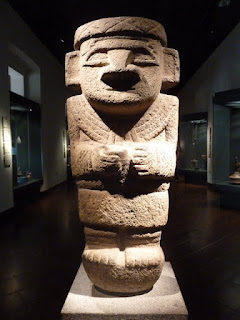To answer a question from a reader, the last photo in my last post is the Virgin Mary, or Maria as she's called in spanish-speaking countries. She stands atop San Christobol Hill, which overlooks Santiago and which can be scaled by a funicular. There is also a small church atop the hill, but I think most people go to see the statue of Maria and the view of Santiago.
 |
| This was really steep -- maybe as much as 45 degrees. |
 |
| At night, she can be seen by much of the city, floating atop the hill. |
In addition to exploring the hill, I spent most of the day walking around downtown Santiago and visiting a couple of the more famous cultural sites. Santiago has about 4 million people and is very spread out, but the center of the city is fairly compact and walkable, or can be easily transversed on the Metro. It reminded me a lot of Washington, D.C., or maybe some generic european city. Fairly pretty, with some random ugly buildings from the 1960s thrown in. A combination of wide streets and narrow streets. And a river running through the middle of the city.
 |
| This might be the Parliament building. Not certain, though. |
 |
| The Plaza de Armas. |
The neighborhood Barrio Bellavista is one of the cooler neighborhoods, and is a popular spot for dining and drinking. I liked it for its fun architecture and street art:
My first stop of the day was the Museum of Pre-Columbian Art, which houses art -- mostly pottery, stonework, coppers and textiles -- from all over Central and South America and dating back to as early as 5,000 B.C. I didn't know a lot of pre-Columbian art (and still don't) and I was impressed by how detailed and exquisite it is. I'm going to describe more of the museum in another post, because I learned some unusual things there, and want to talk about them in more detail.
After the museum I walked through the town and headed up the hill, then back down to see the restored La Chascona, which is the house of the famous chilean poet and politician
Pablo Neruda. Actually I wonder how famous he is, because I never heard of him, although he
did win the Nobel Prize for literature. I am pretty ignorant about pretty much everything having to do with South America, despite it being relatively close to home and with a relatively accessable (ie, european-based) culture. Ah well, I'm learning a bit now.
Back to Pablo's home: He was a man who loved boats and everything to do with the sea, but being on the sea made him sick. So he built himself a home that is like a boat. Small rooms, low ceilings, passageways, bunks, etc. The home is actually made up of three mini-homes. Two of them contain living quarters and the third is mostly his library and study. He's been dead for almost 40 years, and Pinochet troops sacked his home shortly after he died. But his widow and a foundation established in his name restored the home in the 1980s. It's a very cool little place.
 |
| Two of the three mini-houses. |
 |
| The third mini-house: The office and library. |
Two stories from Pablo Neruda's home that I want to remember: One of Matilda (his wife)'s china sets is an unusual pattern: The china is a while base but the decor is super colorful, reminiscent of peacocks, only done in Austin Powers era colors and styles. I really noticed it because about 5 weeks ago, I saw the exact same pattern in an antique store near Miriam and Mark's. I really admired it at the time but of course I didn't think about buying it because it was quite expensive, I was far from home, and I don't really have a home at the moment anyway. But it was neat to see such an unusual pattern twice in about 5 weeks, when I'd never seen it before at all.
The other story is about Pablo's wife Matilda. My guide (I was the lone english-speaking visitor late this afternoon; there don't seem to be a lot of tourists here) told me that Matilda had been his mistress since the early 1940s, while Pablo was still married to his second wife. Then Pablo got a divorce in about 1955, and married Matilda in 1966. They stayed together until Pablo's death in 1973. Since they were together for so long, I asked my guide why it took Pablo so long to get a divorce and to marry Matilda. Apparently, when Pablo had been married the first time, to a woman from Europe, he divorced her to marry his second wife -- a woman 20 years his senior. But Chile did not recognize that first divorce because it was done by mail to Europe, but Pablo didn't know it until after his second marriage. Hmm, I guess I missed how/where he got his second divorce from his second wife, but whatever... that happened in 1955. In the meantime, Chile treated Pablo as still married to his first wife until the year she died 1965 -- then he married Matilda the following year. Matilda died in the mid 1980s and Pablo's second wife lived to be about 100 years old, and died in the 1990s.
Finally, for you food or chocolate lovers, I have to share the chocolate drink I had today:
Chocolate caliente (recipe in link). It sounds really simple -- just blocks of chocolate melted and whipped into a froth -- and it was
really yummy. Considering how simple it sounds to make, I can't believe I never had it before. See how the chocolate clings to the spoon? I didn't try to drink it, I ate it like a thick soup. Thick chocolate soup.












No comments:
Post a Comment